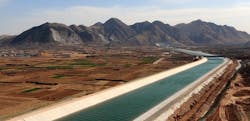China’s South-North transfer “critical” to avoid a water crisis
With the Central Route of China’s South-North Water Transfer (SNWT) project finished in October, experts have said that completion of the ambitious project is critical if the country is to carry on developing at its current rate.
Originally an idea from Chairman Mao back in 1952, China’s SNWT was thought up to help the country overcome a major stumbling block: the North is responsible for the majority of industrial activity yet lacks the much need water that lies in the South.
Approved in 2002, the initial Eastern Route was completed in 2013. This involved deepening and broadening the existing Grand Canal, built some 1400 years ago to take 14.8 billion cubic metres of water a year more than 1,000km north from the Yangzi River towards the city of Tianjin.
In October this year, the second arm of the SNWT- known as the Central Route - was completed. Stretching over 1200 km northward, the central part of the ambitious project was under construction for 11 years.
Originally thought to cost $15 billion, current estimates now put the total project at $62 billion.
In October reports suggested there is a far bigger cost taking its toll on the country: around 330,000 people have been resettled to make way for the project, with local estimates putting this number nearer half a million.
Simon Spooner, consultant at Atkins Water & Environment International and honorary professor at Nottingham University Ningbo, Chin, told WWi magazine: “While never easy for those concerned I think the problems of resettlement have been played up in the press. This sort of resettlement goes on all the time in China. It’s constant.
"They’re transforming their entire society. You’ve got tens of millions of people a year moving from the country to the cities. This requires having to build new urban infrastructure, accommodation and to reorganise the villages. It’s probably the biggest migration in human history that is going on in China right now.”
Discussing the requirement for the South-North transfer, Spooner added: “In the Hai river basin around Beijing they are using more than 100% of total water resources that are available. You’ve got a desperate situation. The government has had to do something about this – otherwise Beijing will run out of water and a lot of the cities will have serious problems and will not be able to grow. It will cause a crisis."
- The full-length feature addressing the latest developments of China’s SNWT will appear in the December-January edition of WWi magazine. To find out more, subscribe for free here.
###
Read/watch more
VIDEO: East Moves West as BEWG Expands Dr Peng explains why BEWG is investing to expand from China into the billion dollar global market…
Membranes in China: Boom or Bust for International Manufacturers? Although China’s Five-Year Plan is encouraging for desalination, a goal stipulating that 70% of parts use in projects should be supplied domestically is perhaps not for international companies…
Beijing sludge contract helps Cambi enter Chinese market Beijing Drainage Construction Co. has awarded Cambi UK a contract to supply Thermal Hydrolysis Process (THP) technology to one of the largest sludge treatment projects in China…
About the Author

Tom Freyberg
Tom Freyberg is an experienced environmental journalist, having worked across a variety of business-to-business titles. Since joining Pennwell in 2010, he has been influential in developing international partnerships for the water brand and has overseen digital developments, including 360 degree video case studies. He has interviewed high level figures, including NYSE CEO’s and Environmental Ministers. A known figure in the global water industry, Tom has chaired and spoken at conferences around the world, from Helsinki, to London and Singapore. An English graduate from Exeter University, Tom completed his PMA journalism training in London.
